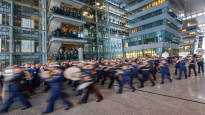NATO was founded in 1949, when there were 12 countries in the alliance. Now there are 32 of them.
Today, Thursday, it will be 75 years since NATO was founded. At the same time, Finland celebrated its first anniversary in NATO and several Eastern European countries celebrated their 20th anniversary. The union has grown from 12 members to 32.
NATO says it is bigger and stronger than ever.
In his speech, the Secretary General of NATO Jens Stoltenberg highlighted three turning points in the history of the alliance: the Balkan crisis, the terrorist attack on the United States and the occupation of Crimea.
At the time of the Balkan crisis in the 90s, NATO focused on crisis management. After the attack on the twin towers, countries waged a war on terrorism.
The occupation of Crimea in 2014 started a development, when NATO returned to its original mission: to defend its members. It also took on the task of supporting Ukraine after Russia invaded the country in 2022.
The original Washington agreement was displayed in a display case in the agora of the NATO headquarters in Brussels, where foreign ministers and the NATO leadership celebrated the anniversary.
The contract 14 articles stipulate, among other things, that allies must jointly and severally ensure their ability to respond to an attack (Article 3), and an attack against one is an attack against all (Article 5).
NATO was created in the post-World War II world, where the threat of communism hovered and Europe was largely in ruins. The purpose was to unite Europe and the United States against the threat of communism and Russia.
The relations between NATO and Russia have fluctuated with the winds of geopolitics and the current leadership of Russia, from the Cold War to some kind of understanding. At the moment, relations are practically frozen, and there is no discussion with Russia.
The anniversary was celebrated in connection with the meeting of foreign ministers. The ministerial meeting has discussed supporting Ukraine.
NATO is preparing to support Ukraine for years or decades. This means donating weapons and building the country’s society and military to be NATO-worthy.
NATO countries support Ukraine a lot with weapons, but not so much that Ukraine could defend itself from Russia as it wants. Foreign minister of Ukraine who visited the meeting of foreign ministers Dmytro Kuleba said he has one message and one wish: Patriot missiles. American-made Patriots are effective anti-aircraft missiles.
This is related to NATO’s first concern: Russia’s attack on Ukraine revealed that Europe’s defense capability is not at the level it should be. European countries allowed their weapons stockpiles to run out after the end of the Cold War, and so far the market has not produced enough weapons to replenish their own or Ukraine’s stockpiles.
Some NATO countries have a lot of work to do to get their defenses in such condition that if the army was needed, it would actually be able to fight. This year, only 18 member countries will reach the alliance’s goal of spending two percent of the gross national product on defense.
Another concern relates to the role of the United States in NATO. Europe’s defense and NATO’s deterrence largely rely on the United States. Early favorite for the November presidential election Donald Trump has used lush rhetoric about NATO countries not paying their share of defense.
In his speech, Stoltenberg spoke about Europe and the United States.
– I don’t believe in the United States alone. Just like I don’t believe in Europe alone. I believe in the United States and Europe together, in NATO, Stoltenberg said.
